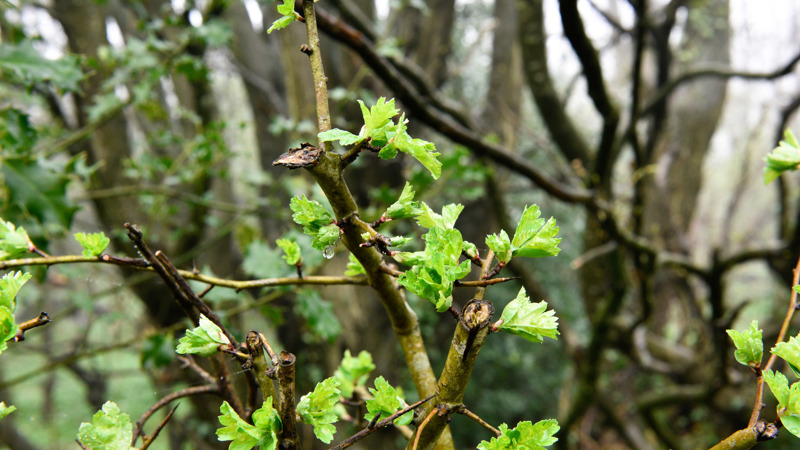Tree management
How we maintain trees. When we do and don't prune or fell trees on our land.

On this page:
Promoting wildlife and biodiversity
Trees and plants are part of our 'soft estate' - the natural or 'green' part of our land that includes woodlands, landscape plots and individual trees.
We want to foster a rich biodiversity across our soft estate that will be resilient and sustainable against climate change, pollution and other threats.
Trees are a very important part of this, whether we plant them ourselves or they are growing naturally on our land.
When do we do tree work?
Pruning and tree management is part of our regular maintenance activities, as well as our first course of action (rather than felling).
Reasons we prune trees include:
Good management
We remove dead, diseased or damaged wood so that trees can grow strong and healthy.
Pruning is also an essential part of maintaining woodland and tree planting-plots.
Preventing obstruction
Where tree branches obstruct a public highway, public right of way, footpath, entrance to property or open space with public access.
We generally keep minimum clearances of
- 2.4 metres over pedestrian accesses
- 3 metres over cycleways and bridleways
- 5.2 metres over road carriageways
We also prune to stop trees:
- obscuring road signs, street lighting and other services equipment
- blocking police or our own CCTV cameras
Visibility
Where trees block sight lines on roads - for example at junctions, bends and entrances.
Nuisance
Where a tree causes a legal nuisance to neighbouring properties. This means a nuisance that is actionable in law.
For example, when trees are actually touching buildings and causing direct damage.
Repairs, maintenance and construction
Where trees are hindering or stopping property repairs and maintenance, or authorised construction work.
Crime prevention
We prune to stop trees being used by criminals to aid their activity, for example robbery, assault, burglary or escaping capture.
Tree roots
We avoid pruning tree roots wherever possible.
Pruning supporting roots can make trees unstable. Cutting off more than 30% of a tree’s root system will probably kill it slowly. Even cutting away smaller roots over a big enough area can stop a tree picking up enough water and nutrients to keep it healthy
We don't prune roots unless:
- we've considered all other alternative options
- we have specialist advice that pruning won't damage the tree's health and structure
Where tree roots are damaging footways, we try to raise the level of the path above the roots. If building up the footpath won't remove the trip hazard, we'll seek specialist advice to find a solution that won't weaken the tree.
When do we fell trees?
We only fell trees as a last resort, after taking specialist advice.
We avoid felling trees wherever possible and will always try to solve problems by pruning or other methods of management first
We don't fell trees without very good reasons, for instance:
- when a dead or dying or damaged tree is a hazard to public safety
- if a tree is actually blocking a public highway, public right of way, access to property or footpath.
Structural damage
We only fell trees if they are the major cause of serious structural damage to buildings. This includes soil shrinkage - where soil shrinks (for example through lack of moisture) and removes support from a structure.
We carefully investigate claims of structural damage and expect them to be backed by evidence, usually an independent structural engineer's report.
Wrong species or location
We may have to fell trees if they're growing in the wrong place. For instance, if:
- a tree is growing too close to a road
- a tree has grown to a size where it's roots are breaking up footpaths. We'll try other approaches first, such as raising the footpath level
Sometimes we have to remove trees just because their species is unsafe in a certain place. For example, Poplar trees, which are prone to break, aren't safe next to roads.
Promoting wildlife and biodiversity
If dead trees are standing steady and upright and there's no safety risk, or risk of disease, we preserve them as valuable wildlife habitats.
We only cut out dead wood if it's a hazard, or it risks overbalancing a tree and making it topple. Where possible, we'll leave the dead wood we cut on the ground, to become a habitat itself.
Natural damage and decay can create cracks and holes on mature trees that become useful homes for animals and plants.
Trees like this are known as 'veteran trees'.
Where we can, we use various techniques to encourage this 'veteranisation' process. We record veteran trees in our soft estate asset inventory.
Sometimes it's necessary to fell or thin trees out in order to create diverse habitats.
For example, by removing trees to let light into planting plots, we can allow more types of plants and animals to thrive.
Do you think trees on our land may be affecting your house or property
Trees near your property gives you more information.
